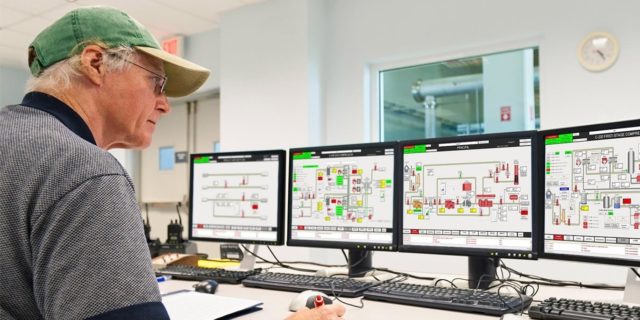Understanding SCADA (Supervisory Control and Data Acquisition) systems play a vital role in industrial automation. Their main function is data acquisition; specifically, supervision, control, and supervision functions. SCADA systems typically consist of computers designed for this task as well as peripheral devices like Remote Terminal Units (RTUs), I/O modules and Programmable Logic Controllers (PLCs) to interface with process machinery as well as communication networks to allow exchange of information between peripheral devices and supervisory computers.
Table of Contents
Key Functions of SCADA
Supervision
SCADA’s supervisory function allows operators to gain an immediate overview of process status and to monitor how it progresses over time by analyzing sequence of operating states. A primary task of supervision is creating an HMI which gives an operator a prompt and complete picture of all aspects of process including status, evolution, and any unexpected deviations (alarms). Graphic representation of information pertinent to process plays an integral part in creating an understandable visual language for operators.
Control
The control function of a SCADA system entails its ability to interact with and modify the controlled process based on pre-established rules or decisions made by an operator, altering its evolution in response to pre-established rules or decisions taken by them. It’s important to remember that SCADA does not represent real-time process control like PLC; rather it means altering its evolution with features like sending different work recipes for example.
Data Acquisition
Data acquisition refers to the transfer of information between peripheral devices and supervisory computers and vice versa. This enables a supervisory system to direct process evolution by altering variables that influence its operation; data acquisition is the main function performed by SCADA systems by connecting processes directly with their monitoring. By providing all available status data necessary for monitoring operations, data acquisition helps provide complete monitoring information necessary for overseeing them effectively.
SCADA Systems Provide Many Advantages
SCADA applications are used extensively across industries and provide an invaluable aid for companies of any size or sector of activity. SCADA systems offer several advantages over traditional data collection methods, including:
SCADA systems collect, save, and make available all system status data for further processing aimed at quality control, efficiency improvement, and production optimization.
SCADA systems give operators a clear picture of production plant operations: SCADA systems provide an operator with a graphical depiction of all aspects of production process development over time as well as any anomalies or abnormalities that arise.
Adapting to Company Growth: Due to its modular and flexible structure, SCADA software allows companies to adapt quickly to various situations that arise when expanding or restructuring.
SCADA applications provide remote control of peripheral units and enable technical staff to easily access all information via browsers.
SCADA, IoT and Industry 4.0
With cloud applications becoming more widely adopted, SCADA technologies have advanced towards integration with the Internet of Things (IoT). SCADA systems can expand upon IoT potential. By integrating both technologies, you can obtain faster, more comprehensive, and safer collection and verification of company data. These systems are specially tailored to manage remote maintenance, remote diagnosis, and remote control; monitor and regulate working conditions of machines; control energy and water consumption while lowering emissions; as well as controlling quality at production system level and related processes. Key enabling technologies of Industry 4.0 such as SCADA, IoT, cloud, big data analytics and cybersecurity all play an integral part.
Types of SCADA Systems
SCADA systems can be classified according to three primary criteria: software platform type, system architecture design and real-time requirements.
Software Platform: SCADA systems may be built using dedicated platforms, designed specifically to monitor a particular machine or plant, or open platforms which offer users an Integrated Development Environment for creating SCADA apps.
System Architecture: SCADA systems may consist of either one supervisory PC connecting directly to field devices or multiple supervisory PCs connected by local area networking or public internet and distributed on multiple hierarchical levels.
Real-Time Requirements: Not all SCADA systems have strict real-time requirements, while others do so often with multiple microcontrollers connected via local networks to one another and to a supervisory PC, using deterministic operating systems capable of producing responses times measured in thousandths of seconds.
Selecting the Appropriate SCADA Software
Selecting the most suitable SCADA software depends on many factors, including its complexity in relation to developing an app, required performances, any restrictions imposed by customers and available budget. It is also essential to take learning times into consideration; complex systems typically take more time for learning. When selecting SCADA software, it should always be done so with balance between desired performance and overall costs such as license fees and development and learning times in mind.



![Best Free Mobile Remote Desktop App [iOS & Android] Free Mobile Remote Desktop App](https://techniciansnow.com/wp-content/uploads/2024/01/Free-Mobile-Remote-Desktop-App.jpg)




